Wrangler Keeps Changing, but Stays the Same
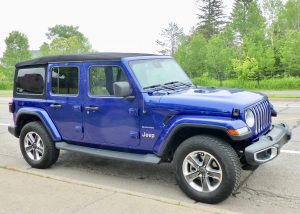
Same familiar look, but the new Jeep Wrangler has considerable refinement beneath the stunning blue paint.
By John Gilbert
It’s been quite a model year for FCA already. FCA, of course, stands for Fiat Chrysler Automobiles, and it encompasses the Italian parent Fiat, along with what used to be Chrysler Corporation — Chrysler, Dodge, Jeep and Ram — blended into Fiat and its impressive holdings, Ferrari, Alfa Romeo, Lancia, and, of course, Fiat.
Thanks to Ram and Jeep, FCA has seemed to have withstood the current woes plaguing the global auto industry, in which cars are in the downward stroke of the vehicle-buying pendulum, headed for what many executives at General Motors and Ford see as oblivion, displaced by the upsurge of trucks — all manner of trucks and SUVs, which have zoomed past cars in popularity and profitability.
Ford has declared it will stop building almost all cars — Taurus, Fusion, Focus, Escort, you name it — to make room for building more trucks. GM says the same thing, planning to eliminate all sorts of historically significant vehicle nameplates in order to convert plants from cars to trucks, trucks and more trucks.
It’s the same with Toyota, which is even now changing over a plant that builds Corolla compacts to accommodated building more RAV4 crossover SUVs — now the top nameplate at Toyota, even outselling Camry and Corolla.
FCA has not ignored the trend, and is eliminating a few cars, although it has fewer cars than Ford or GM. It sounds as though the Charger and Challenger will remain, but parent and dutiful owner Fiat is watching closely and pulling the strings. Ram trucks, and the amazing Jeep line of utility vehicles have carried the corporation’s stabilization.
The Ford F150 pickup remains the top-selling vehicle in the U.S., but has leveled off, and the traditional runner-up, the Chevrolet Silverado, has fallen off even more in their annual duel of full-size trucks. Despite the tiresome late-night and sports-event ad campaign coming at you with alleged “real people, not actors” who rave about how much more they love the Chevy truck — including one that says, “I traded my Ram for a Silverado” — one of the more startling bits of information is the current marketplace results.
With a classy redesign and an amazingly attractive interior, word out of Detroit was that the Ram outsold the Silverado almost 2-to-1 in the month of June, something I found hard to believe, based on habitual U.S. buyers and their knee-jerk habits.
All of which brings us to today’s topic, which is: Jeep.
While the auto industry has struggled for most of this model year, FCA has improved its total foothold, thanks to the Ram and the Jeeps. The Challenger and Charger remain high-performance muscle-car throwbacks, and the Pacifica minivans, improved though they are with their latest hybrid models, have dropped off a bit and FCA is thinking about adding a renewed Caravan or Voyager base minivan that could sell for less than the high-tech Pacifica.
Jeep, meanwhile, stands alone as one of the most interesting and curious brands. It has some very impressive new family models, such as the Grand Cherokee, the Cherokee, the Compass and the compact Renegade, but the backbone of the whole Jeep line is the Wrangler — the basic, off-road specialist that has been refined thoroughly and repeatedly to become more “civilized” but without losing any of its quite-amazing off-road capability. And you can’t get more civilized than the flashy blue paint on my test Wrangler.
The Wrangler proved it is refined to the point where, amid dozens of compact SUVs taking over the marketplace, Motor Trend tested 20 or more and named the new Wrangler as its “SUV of the Year” for 2019. Incidentally, Motor Trend recently decided to add a third candidate evaluation with SUVs added to the traditional car and truck of the year listings, and the Ram was named Truck of the Year, giving FCA two of the exalted three awards.
I wouldn’t have named the Wrangler SUV of the year in the face of some overwhelming and impressive competition, although when competition gets so tough, it’s understandable why Motor Trend every once in a while clears the air by naming something like the off-roading specialty Wrangler. I am completely impressed with the Wrangler, and those who spend any recreational time off-roading will celebrate the award.
Recently, I had the chance to revisit the 2019 Wrangler, and a mid-summer test week verified my earlier findings that the 2019 Wrangler has made that giant step up to become a worthy family vehicle, with the elimination of the pogo-stick bounciness that I thought was standard equipment on Wranglers.
You could safely say that the Wrangler has made a positive change in -road onrefinement without giving up any of its traditional and historic capabilities off-road. Besides, it’s absolutely cool.
My test vehicle’s biggest obstacle was its name. It was the Jeep Wrangler Unlimited, and indication that it is equipped for heavy-duty use. It was the Unlimited’s elite Sahara model, which means fancier features that shouldn’t prevent it from bounding over the Sahara Desert’s sand dunes like the old television series “Rat Patrol,” which made World War II Jeeps its central figures. And it was “Trail Rated,” which means it is built to go anywhere, whether there are roads or not.
That’s it: The 2019 Jeep Wrangler Unlimited Sahara 4X4, Trail Rated.” But when you want to bring all those subtitles into the spotlight, so the guy parked next to you at the ballgame won’t think you have just an ordinary Jeep, you get silver badges that say “Jeep” in familiar bold type, and above that a smaller “Sahara,” and above that a round emblem that denotes the “Trail Rated” capability.
Fortunately, there was no available room to add to the price tag, either: $52,210. That’s up from the base price of $38,395, and reflects the addition of all sorts of modern conveniences, such as the back-up camera, the third generation Dana rear axle over the heavy-duty suspension with its gas-charged shocks, skid plates and shields protecting the fuel tank, the transmission and the transfer case, a trailer-sway damping feature, electronic stability control and roll mitigation, security device, and, it says here, universal garage door opener.
Those are standard on this model, and there are options added on, including: leather trimmed seats with “Sahara” embossed, cold weather package with heated seats and steering wheel, remote start, LED reflector headlights, foglights, taillights and daytime running lights, a premium audio system, rear park-assist, blind-spot detection, hill-descent control, and full frontal collision avoidance. Oh yeah, and there’s satellite radio, push-button start, and a GPS that plays out on a center stack screen.
You think those Rat Patrol ruffians might have enjoyed those features?
It was blue, but hardly a garden-variety blue. Named “Ocean Blue Metallic Clearcoat,” that moniker falls short of defining the stunningly deep blue that penetrates your senses like a laser-beam.
Among the selections you are required to make is with the engine. There is, you should know, still another upgrade, to the “Rubicon” model, which includes the 3.6-liter V6 engine, although I am convinced the way to buy the Wrangler is with the new 2.0-liter 4-cylinder I had in the tester.
Consider these facts: The 3.6 V6 has 285 horsepower to the 2.0’s 270; but the V6’s healthy 260 foot-pounds of torque can’t beat the 2.0’s 295 foot-pounds. The V6 has a 6-speed automatic, the 2.0 gets the new 8-speed.
The lighter 4-cylinder also aids the Wrangler’s agility, with improved balance, although both, of course, have part-time 4-wheel drive that can be locked into your choice of settings. When on the road, you probably would choose the rear-wheel-drive only setting to aid fuel economy, and be impressed with something approaching sporty car handling.
Those who have driven or ridden in Wranglers from a decade or two ago might still recall how potent it is in clamoring over rocks and hilly terrain, seemingly without regard to how steep the challenge might be. If your experience with Jeeps is more contemporary, as in the luxurious Grand Cherokee, then you might look on the Wrangler with scorn, assuming it to be primitive.
Never, however, assume. The new Wrangler Whatsitsname will still do everything the old off-road-beating, rugged rock climber will do, but now it cleans up to transport you and your family to the country club. It even has a partial soft-top to turn it into a virtual convertible. We won’t get into removing the doors and leaving the rollbar -quality support structure exposed as you bound off-road.
I still don’t know that I would name it SUV of the Year, but I’m pretty sure that if and when you choose an alternative vehicle for that honor, the Wrangler will beat it off the road, and maybe on the road, too.


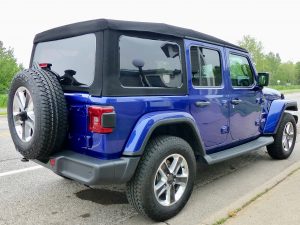
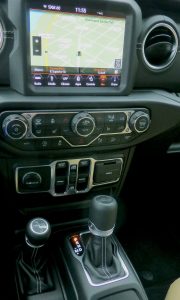
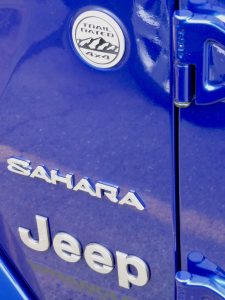
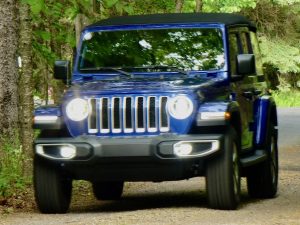
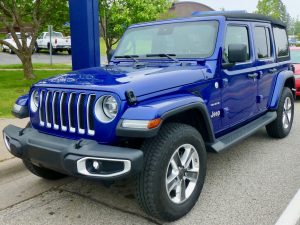
 John Gilbert is a lifetime Minnesotan and career journalist, specializing in cars and sports during and since spending 30 years at the Minneapolis Tribune, now the Star Tribune. More recently, he has continued translating the high-tech world of autos and sharing his passionate insights as a freelance writer/photographer/broadcaster. A member of the prestigious North American Car and Truck of the Year jury since 1993. John can be heard Monday-Friday from 9-11am on 610 KDAL(www.kdal610.com) on the "John Gilbert Show," and writes a column in the Duluth Reader.
John Gilbert is a lifetime Minnesotan and career journalist, specializing in cars and sports during and since spending 30 years at the Minneapolis Tribune, now the Star Tribune. More recently, he has continued translating the high-tech world of autos and sharing his passionate insights as a freelance writer/photographer/broadcaster. A member of the prestigious North American Car and Truck of the Year jury since 1993. John can be heard Monday-Friday from 9-11am on 610 KDAL(www.kdal610.com) on the "John Gilbert Show," and writes a column in the Duluth Reader.